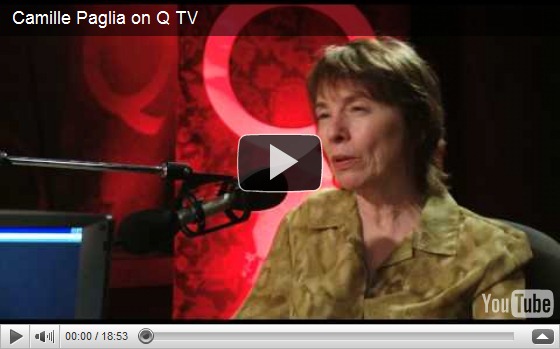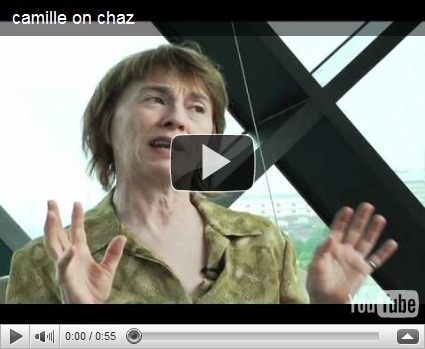She did a PhD at Yale 1968-72 where she was openly lesbian, and was mentored by Harold Bloom. Paglia taught at Bennington College, Vermont from 1972. One of her students was Judith Butler.
In 1973 Carolyn Heilbrun issued her tepid Towards a Recognition of Androgyny. Paglia, then an unknown, reviewed it anonymously in the Yale Review:
"Heilbrun's book is so poorly researched that it may disgrace the subject in the eyes of serious scholars".
She fell out with her colleagues at Bennington College. After a standoff with the administration, she accepted a settlement and resigned in 1979. She supported herself with part-time positions, and some journalism. She completed the book version of Sexual Personae, but could not get it published. In 1984, she was hired to teach humanities by the Philadelphia College of Performing Arts, which merged in 1987 with the Philadelphia College of Art to become the University of the Arts.
In 1990 Sexual Personae was published by Yale University Press. In it she analyzes Western art in terms of the contrast between Dionysos and Apollo, an approach that had been pioneered by Friedrich Nietzsche. Unlike Nietzsche she contrasts masculine, phallic sky religion with feminine, chthonic, earth religion, and portrays culture as a struggle between the two. She find paganism undefeated by Judeo-Christianity, androgyny, sadism and the aggressive Western eye in both classical art and pop culture. Against the feminism of the 1980s she stresses the biological basis of gender differences. She identifies 23 sexual personae which she labels:
All 23 are androgynous in different ways. The power of androgyny comes through in three key concepts:Amazon, androgyne of manners, android, beautiful boy, court hermaphrodite, dandy, Decadent aesthete, drag queen, Epicoene, Gorgon, Great Mother, Khepera, lesbian, male heroine, manufactured object, Mercurius, Pythoness, Teiresias, transsexual, twin, vampire, Venus Barbata, virago.
Charisma, the radiance produced by the interaction of male and female elements in a gifted personality. The charismatic woman has a masculine force and severity. The charismatic man has an entrancing female beauty. Both are hot and cold, glowing with presexual self-love (p521);
Psychoiconicism, the literary phenomenon where a dominant androgyne so dominates a text that both the plot and other characters lose fictive energy and fade into the background. She specifies the examples of Geraldine in Coleridge's poem 'Christabel'; Rosalind in Shakespeare's As You Like It; Virginia Woolf's Orlando; Heathcliff in Emily Bronte's Wuthering Heights; Oscar Wilde's Dorian Gray. Wuthering Heights and Orlando in particular weaken in their second half once the authors Sexual Metathesis, expressed in a fascination with the central character, is completed and there remains a struggle to complete the plot (p345 );
Sexual Metathesis, the special erotic thrill produced by a change in gender. Several of the literary examples disguise a gay relationship, but the public evasion is no more than a small part. 'An ampler spiritual economy is at work. Sexual metathesis is a metaphysical advance, an expansion of identity through a mentally prolonged erotic sensation’ (p350,455).
All this of course refers to the androgyny inherent in our culture. She says very little about real-life trans persons. The major statement is on p368:
"We are still untangling the legal and and moral problems caused by the invention of a new sex, the transsexual, produced by chemical and surgical manipulations of the body. The transsexual is a technological androgyne whom we are happy to call 'she' out of the courtesy owed to all inspired makers of fiction. Close to transsexual is my favorite technological androgyne, Luciana Avedon, formerly the Princess Pignatelli, who radically resculpted face and body in her quest for beauty."The book drew strong criticisms, both pro and con. Sexual Personae was nominated for a National Book Award and after being released as a paperback became a best-seller. She said that a second volume focused on popular culture had also been written, but the book has never appeared.
Two years later she released Sex, Art and American Culture: Essays which contains her critical review of Marjorie Garber's Vested Interests, and "Junk Bonds and Corporate Raiders: Academe in the Hour of the Wolf" in which she tackles Foucault, Halperin and their ilk for their ignorance of earlier theorists and their ignorance of culture in general. This essay was much discussed even by classical historians. She expresses enthusiasm for drag queens:
"I sensed then, and now know for certain, that Madonna, like me, is drawn to drag queens for their daring, flamboyant insight into sex roles, which they see far more clearly and historically than do our endlessly complaining feminists. (p9) ... The castrated, tranvestite priests of Cybele, honored in disco-like rites of orgiastic dance, survive in today's glamourous, flamboyant drag queens. (p23) ...The drag queen has emerged in America in the Nineties as a symbol of our sexual crisis. A pagan priest whose ancestry is in the ancient cults of the Great Mother, the drag queen defies victim-centered feminism by asserting the dominance of woman in the universe. (p99) ...You know, I'm really happy there wasn't all this talk about sex changes back then, since I probably would have gotten this fantasy that I was a man born in a woman's body, and I think that I might very well have become obsessed with the idea of a sex change, which would have been a terrible mistake.... I've acclimatised myself to to my sex role -- thanks to gay men and drag queens! Drag queens have influenced me enormously. Their analysis of the mythology of male and female and the theater of gender and so on, I've absolutely taken into myself. (p256)"She became a media celebrity known for her disagreements with other feminists and media pundits. Because she would not conform to the left-wing party lines, she was dismissed as a conservative, but regards herself as a libertarian Democrat, with pro-choice positions on abortion, pornography, euthanasia etc.
Her first movie was Female Misbehavior, 1992, where she is profiled along with Annie Sprinkle and trans man Max Valerio. In It's Pat, 1994, a street gang have a battered copy of Sexual Personae and accuse Pat of being an androgyne, which s/he is. Paglia has appeared in 38 films, usually playing herself. In 2001 she recorded a commentary track for the DVD of Basic Instinct. She wrote regular columns for Interview Magazine and Salon.
She was partnered with Allison Maddex 1993-2007 and legally adopted Maddex' son.
In 2009 (although the segment was not released until May 2011), in an interview with Xtra, Paglia confirmed the suspicion that she does not really understand what transsexuality is by opposing Chaz Bono's decision about himself, by referring to him as 'she' and 'Chastity', and repeating that when she was young that she was convinced that she was the wrong gender and if it were allowed that she might have done the same.
- Anonymous (Camille Paglia). "Review of Towards a Recognition of Androgyny". The Yale Review, LXII, 4, 1973.
- Camille Paglia. Sexual Personae: The Androgyne in Literature and Art. PhD Yale 1974.
- Camille Paglia. Sexual Personae. Art and Decadence from Nefertiti to Emily Dickinson. Yale University Press, 1990.
- Camille Paglia. Sex, Art and American Culture: Essays. Vintage, 1992.
- Joan Smith. "Book Review / Madonna of academe: 'Sex, Art and American Culture' - Camille Paglia: Viking, 18.99". The Independent, 10 Jan 1993. www.independent.co.uk/arts-entertainment/book-review—madonna-of-academe-sex-art-and-american-culture--camille-paglia-viking-1899-1477762.html.
- Camille Paglia. Vamps and Tramps: New Essays.Vintage, 1994.
- Camille Paglia. The Birds. BFI Film Classics, 1998.
- Camille Paglia. Break, Blow, Burn: Camille Paglia Reads Forty-three of the World's Best Poems. Pantheon, 2005.
- Robert M. Stewart. "Paglia, Camille (1947 - )". In Alan Soble. Sex from Plato to Paglia: A Philosophical Encyclopedia. Greenwood Press, 2005
- "Camille Paglia". Wikipedia, the free encyclopedia. en.wikipedia.org/wiki/Camille_paglia.
- "Sexual Personae". Wikipedia, the free encyclopedia. en.wikipedia.org/wiki/Sexual_Personae:_Art_and_Decadence_from_Nefertiti_to_Emily_Dickinson.
- "Camille Paglia Biography". Biography Finder. www.biographyfinder.com/s1721-Camille-Paglia-biography.html.
- "Camille Paglia". Biographicon. www.biographicon.com/wiki/dpivu.
- "Paglia, Camille (b. 1947)". glbtq: an encyclopedia of gay, lesbian, bisexual, transgender, & queer culture. www.glbtq.com/literature/paglia_c.html.
Sexual Personae is enormously better than Towards a Recognition of Androgyny. There is probably an eternal dialectic between transsexuality and androgyny, as there is between gender identity and sexual orientation, and Sexual Personae is still the best book about androgyny.
Sexual Personae also has a rare enthusiasm not usually found in books on literature, that sends you to read the original texts. I at least dug out the poems and stories that she discusses to either read them for the first time, or to re-read them.
It was a bit naughty of Xtra in May 2011 to put up the clip of Paglia talking about Bono without mentioning that it had been filmed two years previously.




No comments:
Post a Comment
Comments that constitute non-relevant advertisements will be declined, as will those attempting to be rude. Comments from 'unknown' and anonymous will also be declined. Repeat: Comments from "unknown" will be declined, as will anonymous comments. If you don't have a Google id, I suggest that you type in a name or a pseudonym.